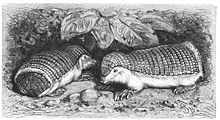The pink fairy armadillo (Chlamyphorus truncatus) or pichiciego is the smallest species of armadillo (mammals of the families Chlamyphoridae and Dasypodidae, recognized by a bony armor shell), first described by R. Harlan in 1825. This desert-adapted animal is endemic to central Argentina and can be found inhabiting sandy plains, dunes, and scrubby grasslands.
Pink fairy armadillos have small eyes, silky yellowish white fur, and a flexible dorsal shell that is solely attached to its body by a thin dorsal membrane. In addition, its spatula-shaped tail protrudes from a vertical plate at the blunt rear of its shell. This creature exhibits nocturnal and solitary habits and has a diet that is mainly composed of insects, worms, snails, and various plant parts.
The conservation status for pink fairy armadillo is still uncertain, and it is listed as Data Deficient by the IUCN Red List of Threatened Species. The decline in population for this species has generally been attributed to farming activities and predators including domestic dogs and cats. Pink fairy armadillos are found less commonly than they were a few decades ago, and the field sightings have been rare and incidental. Individuals that have been caught in the wild had a tendency to die during or a couple days after they were transported from their natural habitat to captive facilities. There is a sole record for the longevity of a pink fairy armadillo that was held in captivity more than 4 years; however, that particular case lacks proper scientific description and thus cannot be considered fully valid. Armadillos' evolutionary distinctiveness, combined with their restricted geographic range, ongoing threats, and rarity makes the urgent conservation attention extremely important for these species.
Burrowing lifestyle Click here
The armadillo has two massive sets of claws on its front and hind limbs help it to dig the burrows in compacted soil very quickly. The pink fairy armadillo is nicknamed the "sand-swimmer" because it is said that it can "burrow through the ground as fast as a fish can swim in the sea."[5] These claws are very big relatively to the size of this animal which makes it difficult for it to walk on a hard surface.
Along with these unique traits, the pink fairy armadillo has greatly reduced eyes and relies highly on touch and hearing to navigate. It also has a torpedo-shaped body in order to reduce the amount of drag it may encounter while working in underground tunnels and a thick, hairless tail that it uses for balance and stability while using its other limbs to dig.
Threats
Due to its subterranean lifestyle, the armadillo is forced to leave its burrows when heavy storms roll in due to the threat of drowning and the risk of wetting its fur. If its fur is wet the armadillo cannot properly thermoregulate and could experience hypothermia during night hours. Once above ground during a rainstorm the armadillo is subject to an array of predators, which can easily get to it since it is not able to burrow back to safety. Domestic dogs have also greatly preyed on these armadillos.
The animals face domestic dogs and cats that forage in their burrows as well as wild boars doing the same. These armadillos also do not do well in captivity. The survival rate is so low that many will die just through transport from where the armadillo was captured to the new area of captivity. Armadillos that are put into captivity typically do not last longer than a few hours or 8 days. In fact, not a single specimen has survived more than 4 years. Which is also a great indicators as to why these species are not good to be kept as pets. Yet many continue to illegally sell them in the black market. These armadillos are very susceptible to climate changes as well; since they inhabit temperate and warm regions, cold temperatures could wipe out its population due to their low metabolism rate and the lack of fat it is able to store. Habitat loss is also a large issue for these species. As the numbers of acres converted to farmland increases, the armadillo's burrows not only get plowed over, but the land is no longer habitable for them. Lastly, the use of pesticides on farmlands is a huge concern because these pesticides adhere to ants, which are the armadillo's primary source of food. If the armadillo ingests enough of these pesticide-infested ants it can be quite detrimental to its health.The over hunting of these animals have contributed to their endangerment. Many in the Americas continue to hunt armadillos for consumption, which is said to be similar to pork in texture and taste.
...
Researchers have found that the pink fairy armadillo is highly subject to stress, making the attempts to apply any conservation policies (including taking it out of its natural environment) unsuccessful and extremely difficult. Any modifications in its environment, external temperature, or diet are known to trigger stress response, which is considered to be a possible reason for the failure of captivity attempts. Also, many of the armadillos have died during the transportation process from their wild habitat, and many more have only survived several days in captivity. Overall, there are only three reports of captive maintenance of pink fairy armadillo that are considered successful - in 1970, 1985, and 2009, reporting individuals to live in captivity for at least 30 months, 22 months, and 8 months respectively.
This armadillo species is found in several protected areas, including the Lihué Calel National Park. Both national and provincial legislation is in place specifically protecting the species.



No comments:
Post a Comment